Month: December 2019
Privatised Push-Back of the Nivin
Forensic Oceanography published the Nivin report.
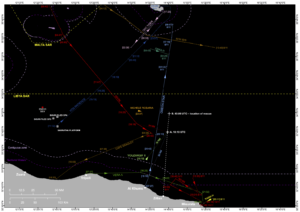
In November 2018, five months after Matteo Salvini was made Italy’s Interior Minister, and began to close the country’s ports to rescued migrants, a group of 93 migrants was forcefully returned to Libya after they were ‘rescued’ by the Nivin, a merchant ship flying the Panamanian flag, in violation of their rights, and in breach of international refugee law.
The migrants’ boat was first sighted in the Libyan Search and Rescue (SAR) Zone by a Spanish surveillance aircraft, part of Operation EUNAVFOR MED – Sophia, the EU’s anti-smuggling mission. The EUNAVFOR MED – Sophia Command passed information to the Italian and Libyan Coast Guards to facilitate the interception and ‘pull-back’ of the vessel to Libya. However, as the Libyan Coast Guard (LYCG) patrol vessels were unable to perform this task, the Italian Coast Guard (ICG) directly contacted the nearby Nivin ‘on behalf of the Libyan Coast Guard’, and tasked it with rescue.
LYCG later assumed coordination of the operation, communicating from an Italian Navy ship moored in Tripoli, and, after the Nivin performed the rescue, directed it towards Libya.
While the passengers were initially told they would be brought to Italy, when they realised they were being returned to Libya, they locked themselves in the hold of the ship.
A standoff ensured in the port of Misrata which lasted ten days, until the captured passengers were violently removed from the vessel by Libyan security forces, detained, and subjected to multiple forms of ill-treatment, including torture.
This case exemplifies a recurrent practice that we refer to as ‘privatised push-back’. This new strategy has been implemented by Italy, in collaboration with the LYCG, since mid-2018, as a new modality of delegated rescue, intended to enforce border control and contain the movement of migrants from the Global South seeking to reach Europe.
This report is an investigation into this case and new pattern of practice.
Using georeferencing and AIS tracking data, Forensic Oceanography reconstructed the trajectories of the migrants’ vessel and the Nivin.
Tracking data was cross-referenced with the testimonies of passengers, the reports by rescue NGO WatchTheMed‘s ‘Alarm Phone’, a civilian hotline for migrants in need of emergency rescue; a report by the owner of the Nivin, which he shared with a civilian rescue organisation, the testimonies of MSF-France staff in Libya, an interview with a high-ranking LYCG official, official responses, and leaked reports from EUNAVFOR MED.
Together, these pieces of evidence corroborate one other, and together form and clarify an overall picture: a system of strategic delegation of rescue, operated by a complex of European actors for the purpose of border enforcement.
When the first–and preferred–modality of this strategic delegation, which operates through LYCG interception and pull-back of the migrants, did not succeed, those actors, including the Maritime Rescue Co-ordination Centre in Rome, opted for a second modality: privatised push-back, implemented through the LYCG and the merchant ship.
Despite the impression of coordination between European actors and the LYCG, control and coordination of such operations remains constantly within the firm hands of European—and, in particular, Italian—actors.
In this case, as well as in others documented in this report, the outcome of the strategy was to deny migrants fleeing Libya the right to leave and request protection in Italy, returning them to a country in which they have faced grave violations. Through this action, Italy has breached its obligation of non-refoulement, one of the cornerstones of international refugee law.
This report is the basis for a legal submission to the United Nations Human Rights Committee by Global Legal Action Network (GLAN) on behalf of an individual who was shot and forcefully removed from the Nivin.
Farewell Alexei
Our main focus of recent months has been fixed on plight of beloved droog and long term collaborator Alexei Blinov. His death just last week of organ failure followed six months of struggle with pancreas and liver cancer, chemotherapy and health services.

A fabulous circle of friends enveloped him with love and support throughout, not least in respect of his creative drive and fierce intellect, but for the huge sense of fun and selflessness he encouraged in all who knew him. A very special friend indeed. A public Transition Celebration is planned for Sunday 15th December at one of Alexei’s favourite bars, Strongroom in Shoreditch London 3-10pm, please come early and celebrate his life and times.. together! A sensational gathering of friends and family shared in the unique celebration of his life and times. It centred around this wonderfully apt and beautifully crafted plasma capsule which scanned and smoothed Alexei’s passing on and up to next phase of further exploration and infinite dreaming. See the growing collection of Alexei images and video clips in this shared album.
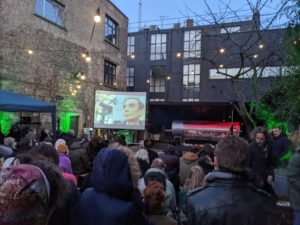


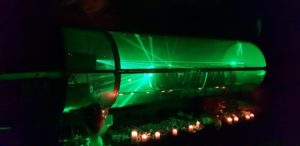
Alexei Blinov (10 July 1964 – 26 November 2019) was a London-based electronic engineer and new media artist working out of Raylab in Haggerston. As founder of experimental new media organisation “Raylab” he has collaborated with a number of creative artists including Jamie Reid.
He was trained as a doctor before moving to the UK. In the early 1990s he specialised in large scale high quality laser projections. Since the late 1990s he has produced a wide variety of interactive audio-visual installations. Over the past few years, he has been the creative force behind many interactive audio-visual art projects in the UK.
Between 1993 and 1996 he worked extensively in the Netherlands, creating laser projections for scientific events, music and arts festivals and for dance companies. Since 1997 he has worked mainly in the UK creating interactive audio-visual installations at a number of important art galleries including the ICA, London and the Barbican Art Centre, London. Collaborations include Ciron Edwards.
From 2006-2016 he led the technical development for feature film Dau – life and times of physicist Lev Landau, on set in the Ukrainian border city Kharkov where he revisited many period experiments and engineered his own to feature in the film. The movie is one of Russia’s largest and most controversial cinematic projects to date.
He engaged with new media projects based on wireless networking such as WiFi, and was a well known and respected I/O specialist with a passion for high voltage and radio frequency experimentation. Blinov researched electro stimulation of neural feedback and blockchain resourcing.
He has exhibited a selection of these HT experiments including the ‘Hairpin Circuit’ at Moscow University. A set of spectacular arctic ICE core holographic images were recently exhibited in St Petersburg.
Alongside Ilze Black and Martin Howse, he was a member of TAKE2030, a brave new media society that operated in parallel net media scheme. The London based collective produced public art projects, shifting social network missions into hypermedia playing fields. Past projects include RichAir2030, UK, EU (2003-2004) and Lets do Lunch, London (2005). Blinov had deep ties with the Open Wireless Network community between Moscow, London and Berlin, collaborating with Jamie Reid, Empress Stah, Shu Lea Cheang, Nancy Mauro-Flude and many others.
He died on 26 November 2019 following complications from pancreatic cancer.
First WG1 EFAP meeting
Working Group 1 met at Tranzit for the first meeting to discuss contexts. The expansion of research across a civil society and the proliferation of practice-based research across academic landscapes have brought about new stakeholder alliances, modes of research, and applications. These are the contexts from which many Advanced Practices emerge. However, many of these initiatives are idiosyncratic (e.g., ad-hoc funding initiatives and/or efforts to think ‘outside the box’); others are deeply embedded in institutions whose cultural roles are evolving (e.g., archives’ efforts to leverage collections in response to shifts in popular interest or intellectual property potentials).
WG1 will survey these shifting contexts in order to ‘map’ currently emerging resources and adjacencies. Its goal is to develop a provisional set of typologies that are:
- descriptive not prescriptive,
- overlapping and non-exclusive, and
- responsive to the needs of different actors/entrants.
These typologies will not serve, even informally, as certification process or ‘registry’ of Advanced Practices; and while WG1’s mandate is to conduct diligent broad-based research, these typologies, by definition, cannot be exhaustive.
Possible typologies might include: areas of interest (e.g., oceans, logistics, national security), practical methods (e.g., rules/guidelines for collaboration), participant needs (e.g., individual or institutional aspiration), and/or formats/techniques of dissemination.
WG1 objective: ‘Map’ emerging resources and adjacencies in order to develop typologies for understanding Advanced Practices.
WG1-specific activities: Identify a wide range visual/textual models for mapping findings; develop flexible/extensible system for annotating typologies and other useful annotations and indexing techniques.
WG1-specific tasks: (1) Develop a shared, rich-media user-writable resource (e.g., a wiki) to maintain provisional typologies linked to examples and supporting resources; (2) identify relevant typologies; and (3) populate and annotate the mapping platform.
WG1 milestones: (1) Setup of online working environments, and (2) publishing a dynamic map of Advanced Practices.
WG1-specific deliverables: Visual maps of annotated typologies of Advanced Practices
A State of Limbo
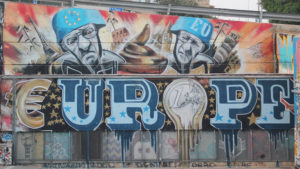
A State of Limbo explores the concept of identity in the Mediterranean at this time of migratory crisis. A multidisciplinary exhibition, large-scale paintings and installations are presented by artist James Micallef Grimaud a.k.a TWITCH. Curated by Rachel Formosa, the exhibition brings forward a visual narrative which examines the socio-political context of an unprecedented crisis in Europe. Featuring elements of street art, the exhibit illustrates the Mediterranean Sea as a paradoxical place, and how populations flock to it in search of freedom. Whilst some do so for pleasure, others seek refuge even though they may not reach their destination. As part of its programme, the exhibition will host hardcore punk band Double Standard, in the Theater of Spazju Kreattiv on Friday the 6th of December.
Curated by Rachel Formosa, a State of Limbo presents a multi-disciplinary exhibition of large-scale paintings and installations by James Micallef Grimaud a.k.a TWITCH, which explore the concept of identity in the Mediterranean at this time of migratory crisis.
FRAGMENTA – Art and Life in Public Space 2013 – 2018
FRAGMENTA book launch “FRAGMENTA – Art and Life in Public Space 2013 – 2018”. You get to see the overview of all events, a mind-blowing selection of Maltese headlines (we wished the headlines extended to 2019 at this point) and celebrate art and life. You can buy copies of the book if you missed the indiegogo campaign. Or collect your preordered ones.
SUNDAY Dec 8th, 5 – 10pm at MAORI, Valletta.
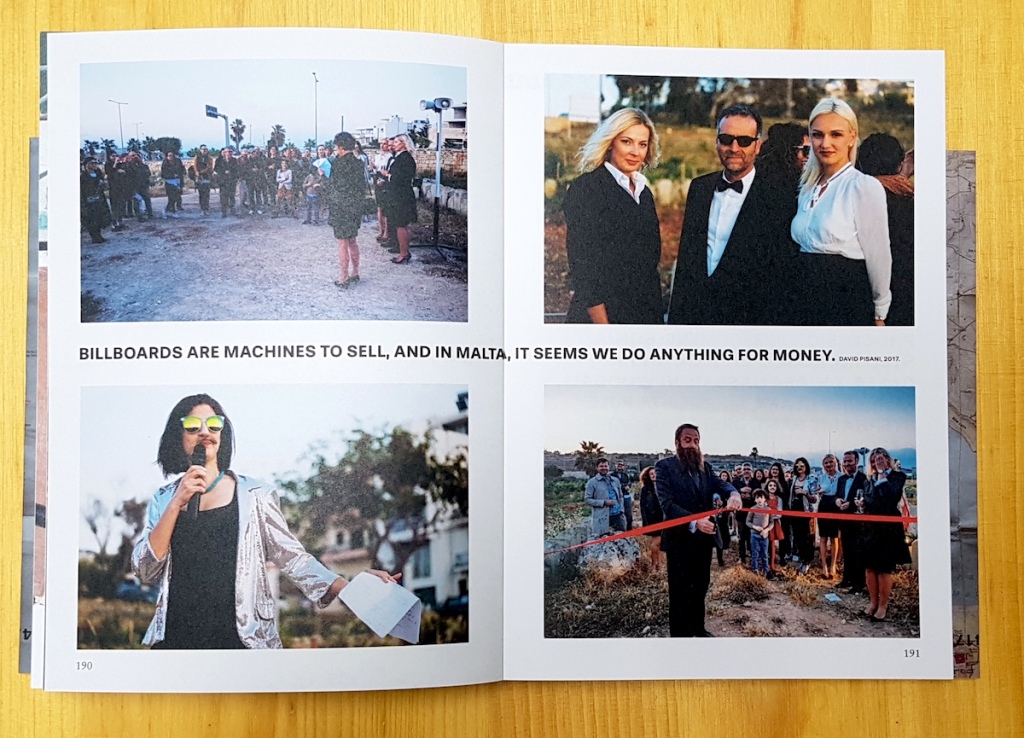
With FRAGMENTA Artists: Jon Banthorpe, Gina Levante, Adrian Abela, Kris Van Dessel, Goele de Bruyn, Aksel Høgenhaug, Ritty Tacsum, Samir Ramdani, Jagna Ciuchta, Bettina Hutschek, Aiden Celeste, Stefan Nestoroski, Alexandra Pace, Hassan Khan, Teresa Sciberras, Roxanne Gatt, Erik Gong, Sandra Zaffarese, Aaron Bezzina, Christof Zwiener, Sonya Schönberger, Charlie Cauchi, Erik Smith, Darrin Zammit-Lupi, Karen Irmer, Anna Block, Sarah Maria Scicluna, Ryan Falzon, Sharon Kivland, Pippin Barr, Carl Gent, David Pisani, Karine Rougier, Kay Turner, Mario Asef
Designed by Jon Banthorpe, printed by LONGO.
The event is free of charge and open to all.
Come any time between 5pm and 10pm. Bring your protest posters.
TIME: Sunday, December 8th, 5pm – 10pm
Location: MAORI. Triq il-lanca, VLT 1820 Valletta



